Episodes

Monday Nov 16, 2020
Episode 405 - Studying Supernova, pollution and air quality with trees
Monday Nov 16, 2020
Monday Nov 16, 2020
Studying supernova and air quality with the help of trees. Supernova are some of the most devastating events in the universe, but what is their connection to trees? By studying tree rings we can help piece together the final days of stars. Supernova can cause large spikes in radiation that can be detected in tree rings. Trees do a lot for us but they can also help us track air quality simply and cheaply. Magnets and pine needles can helps us understand air quality. Air quality monitoring can be a matter of running a magnet over some leaves.
References:
- G. Robert Brakenridge. Solar system exposure to supernova γ radiation. International Journal of Astrobiology, 2020; 1 DOI: 10.1017/S1473550420000348
- Grant Rea‐Downing, Brendon J. Quirk, Courtney L. Wagner, Peter C. Lippert. Evergreen needle magnetization as a proxy for particulate matter pollution in urban environments. GeoHealth, 2020; DOI: 10.1029/2020GH000286

Monday May 25, 2020
Episode 380 - New comets, touching an asteroid and the moon
Monday May 25, 2020
Monday May 25, 2020
New comets, touching down on an asteroid and fake diamonds on the moon. Small objects in our solar system can teach us about the early days of Earth. What happened on the moon 4.5 billion years ago to form cubic zirconia on the surface? What can we learn about the moon 4. billion years ago in dust brought back by Apollo 17? A new comet is appears for the end of May which you can see near sunrise. Another comet discovered by Michael Mattiazzo can be see near sunrise at the end of May. Touching down on an asteroid is an incredible feat, and the preliminary data from Hyabusa2 and Ryugu are fascinating.
- T. Morota, S. Sugita, Y. Cho, M. Kanamaru, E. Tatsumi, N. Sakatani, R. Honda, N. Hirata, H. Kikuchi, M. Yamada, Y. Yokota, S. Kameda, M. Matsuoka, H. Sawada, C. Honda, T. Kouyama, K. Ogawa, H. Suzuki, K. Yoshioka, M. Hayakawa, N. Hirata, M. Hirabayashi, H. Miyamoto, T. Michikami, T. Hiroi, R. Hemmi, O. S. Barnouin, C. M. Ernst, K. Kitazato, T. Nakamura, L. Riu, H. Senshu, H. Kobayashi, S. Sasaki, G. Komatsu, N. Tanabe, Y. Fujii, T. Irie, M. Suemitsu, N. Takaki, C. Sugimoto, K. Yumoto, M. Ishida, H. Kato, K. Moroi, D. Domingue, P. Michel, C. Pilorget, T. Iwata, M. Abe, M. Ohtake, Y. Nakauchi, K. Tsumura, H. Yabuta, Y. Ishihara, R. Noguchi, K. Matsumoto, A. Miura, N. Namiki, S. Tachibana, M. Arakawa, H. Ikeda, K. Wada, T. Mizuno, C. Hirose, S. Hosoda, O. Mori, T. Shimada, S. Soldini, R. Tsukizaki, H. Yano, M. Ozaki, H. Takeuchi, Y. Yamamoto, T. Okada, Y. Shimaki, K. Shirai, Y. Iijima, H. Noda, S. Kikuchi, T. Yamaguchi, N. Ogawa, G. Ono, Y. Mimasu, K. Yoshikawa, T. Takahashi, Y. Takei, A. Fujii, S. Nakazawa, F. Terui, S. Tanaka, M. Yoshikawa, T. Saiki, S. Watanabe, Y. Tsuda. Sample collection from asteroid (162173) Ryugu by Hayabusa2: Implications for surface evolution. Science, 2020; 368 (6491): 654 DOI: 10.1126/science.aaz6306
- NASA/Goddard Space Flight Center. (2020, May 13). New comet discovered by solar observatory. ScienceDaily. Retrieved May 23, 2020 from www.sciencedaily.com/releases/2020/05/200513135517.htm
- L. F. White, A. Černok, J. R. Darling, M. J. Whitehouse, K. H. Joy, C. Cayron, J. Dunlop, K. T. Tait, M. Anand. Evidence of extensive lunar crust formation in impact melt sheets 4,330 Myr ago. Nature Astronomy, 2020; DOI: 10.1038/s41550-020-1092-5

Monday May 18, 2020
Episode 379 - Colourful feathers on dinosaurs and birds today
Monday May 18, 2020
Monday May 18, 2020
Colourful feathers on dinosaurs and their descendants. Sleek, fast, with sharp claws and iridescent feathers, Cassowaries are almost like dinosaurs. How do the cassowaries manage to get that special sheen on their feathers? What gives cassowaries they're menacing iridescence? Long flowing rainbow feathers, all wrapped around a small creature the size of a duck, hardly a terrifying image of a dinosaur. What connects a small duck like dinosaur with a hummingbird? Their iridescent feathers.
- Chad M. Eliason, Julia A. Clarke. Cassowary gloss and a novel form of structural color in birds. Science Advances, 2020; 6 (20): eaba0187 DOI: 10.1126/sciadv.aba0187
- Dongyu Hu, Julia A. Clarke, Chad M. Eliason, Rui Qiu, Quanguo Li, Matthew D. Shawkey, Cuilin Zhao, Liliana D’Alba, Jinkai Jiang, Xing Xu. A bony-crested Jurassic dinosaur with evidence of iridescent plumage highlights complexity in early paravian evolution. Nature Communications, 2018; 9 (1) DOI: 10.1038/s41467-017-02515-y

Monday Apr 06, 2020
Episode 373 - Deep sea reefs, ocean vents and tiny life
Monday Apr 06, 2020
Monday Apr 06, 2020
This week we look at unlikely partnerships that help sea creatures survive and thrive. What plays a crucial role inside a reef's ecosystem that is often overlooked? What's inside fish guts that help keep a reef healthy? Just how do fish 1000s of kms away end up with the same colonies of microbes? Feel like a tasty snack but stuck in the deep ocean vents, why not methane? How do microbes help worms eat methane?
- Shana Goffredi et al. Methanotrophic bacterial symbionts fuel dense populations of deep-sea feather duster worms (Sabellida, Annelida) and extend the spatial influence of methane seepage. Science Advances, 2020 DOI: 10.1126/sciadv.aay8562
- Jarrod J. Scott, Thomas C. Adam, Alain Duran, Deron E. Burkepile, Douglas B. Rasher. Intestinal microbes: an axis of functional diversity among large marine consumers. Proceedings of the Royal Society B: Biological Sciences, 2020; 287 (1924): 20192367 DOI: 10.1098/rspb.2019.2367

Monday Jan 27, 2020
Episode 363 - Mysteries from underwater volcanoes
Monday Jan 27, 2020
Monday Jan 27, 2020
There are mysterious things lurking at the bottom of the ocean, from underwater volcanoes to mysterious graphite. Where did a pumice raft floating across the Pacific come from? Why is a raft of pumice larger than Manhattan heading to Australia? What can we learn by studying petit-spot volcanoes underneath the ocean? What connects young volcanoes with the motion of the tectonic plates? What roll do hydrothermal vents play in the carbon cycle? Where does all this graphite in the oceans come from?
- Philipp A. Brandl, Florian Schmid, Nico Augustin, Ingo Grevemeyer, Richard J. Arculus, Colin W. Devey, Sven Petersen, Margaret Stewart, Heidrun Kopp, Mark D. Hannington. The 6–8 Aug 2019 eruption of ‘Volcano F’ in the Tofua Arc, Tonga. Journal of Volcanology and Geothermal Research, 2019; 106695 DOI: 10.1016/j.jvolgeores.2019.106695
- Naoto Hirano, Shiki Machida, Hirochika Sumino, Kenji Shimizu, Akihiro Tamura, Taisei Morishita, Hideki Iwano, Shuhei Sakata, Teruaki Ishii, Shoji Arai, Shigekazu Yoneda, Tohru Danhara, Takafumi Hirata. Petit-spot volcanoes on the oldest portion of the Pacific plate. Deep Sea Research Part I: Oceanographic Research Papers, 2019; 154: 103142 DOI: 10.1016/j.dsr.2019.103142
- Harry MacKay, C. Anthony Scott, Jack D. Duryea, Maria S. Baker, Eleonora Laritsky, Amanda E. Elson, Theodore Garland, Marta L. Fiorotto, Rui Chen, Yumei Li, Cristian Coarfa, Richard B. Simerly, Robert A. Waterland. DNA methylation in AgRP neurons regulates voluntary exercise behavior in mice. Nature Communications, 2019; 10 (1) DOI: 10.1038/s41467-019-13339-3
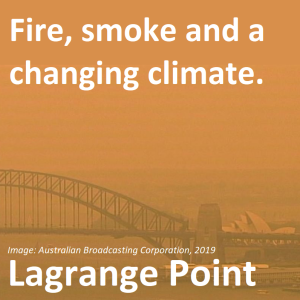
Monday Dec 23, 2019
Episode 358 - Wildfires, climate change, smog and charcoal
Monday Dec 23, 2019
Monday Dec 23, 2019
As the climate changes, wildfires become more common and more dangerous. Smoke clouds from wildfires can linger for weeks, but what chemistry changes inside the smog? Aerosols amongst other particles lurk inside wildfire smoke. How do we study the changes in wildfire smoke; by flying planes through the plumes. How do wildfires impact the CO2 emissions of a region? Can wildfires help store carbon through charcoal? What can charred biomass to do help capture carbon?
- Kouji Adachi, Arthur J. Sedlacek, Lawrence Kleinman, Stephen R. Springston, Jian Wang, Duli Chand, John M. Hubbe, John E. Shilling, Timothy B. Onasch, Takeshi Kinase, Kohei Sakata, Yoshio Takahashi, Peter R. Buseck. Spherical tarball particles form through rapid chemical and physical changes of organic matter in biomass-burning smoke. Proceedings of the National Academy of Sciences, 2019; 201900129 DOI: 10.1073/pnas.1900129116
- Matthew W. Jones, Cristina Santín, Guido R. van der Werf, Stefan H. Doerr. Global fire emissions buffered by the production of pyrogenic carbon. Nature Geoscience, 2019; DOI: 10.1038/s41561-019-0403-x

Monday Dec 16, 2019
Episode 357 - Microbiology vs Macro climate challenges
Monday Dec 16, 2019
Monday Dec 16, 2019
Scientist are turning to microbiology to fight global climate challenges. How do you change a microbe from consumer to producer? Can you teach old e-coli new tricks, and make it consume CO2? How can a gut bacteria start to behave like a plant? Can we use enzymes to produce Hydrogen gas efficiently? What is the missing step in hydrogen fuel cell production? Can synthesised enzyme engines help us produce hydrogen without complex processes?
References:
- Gleizer et al. Conversion of Escherichia coli to Generate All Biomass Carbon from CO2. Cell, 2019 DOI: 10.1016/j.cell.2019.11.009
- The binuclear cluster of [FeFe] hydrogenase is formed with sulfur donated by cysteine of an [Fe(Cys)(CO)2(CN)] organometallic precursor. Proceedings of the National Academy of Sciences, 2019; 116 (42): 20850 DOI: 10.1073/pnas.1913324116

Monday Nov 04, 2019
Episode 351 - A new dwarf planet and what makes an exoplanet habitable
Monday Nov 04, 2019
Monday Nov 04, 2019
What makes a dwarf planet not a planet? What are the rules governing the word planet? Just how many dwarf planets are out there in our solar system? How can we use telescopes and modelling to add or subtract a dwarf planet from that list? We've talked about Goldilocks zone exoplanets, but what about their ability to withstand space weather? What role does a star's magnetic field play in protecting a planet from damaging radiation? Does space weather need to be added to the exoplanet Goldilocks zone?
References:
- P. Vernazza, L. Jorda, P. Ševeček, M. Brož, M. Viikinkoski, J. Hanuš, B. Carry, A. Drouard, M. Ferrais, M. Marsset, F. Marchis, M. Birlan, E. Podlewska-Gaca, E. Jehin, P. Bartczak, G. Dudzinski, J. Berthier, J. Castillo-Rogez, F. Cipriani, F. Colas, F. DeMeo, C. Dumas, J. Durech, R. Fetick, T. Fusco, J. Grice, M. Kaasalainen, A. Kryszczynska, P. Lamy, H. Le Coroller, A. Marciniak, T. Michalowski, P. Michel, N. Rambaux, T. Santana-Ros, P. Tanga, F. Vachier, A. Vigan, O. Witasse, B. Yang, M. Gillon, Z. Benkhaldoun, R. Szakats, R. Hirsch, R. Duffard, A. Chapman, J. L. Maestre. A basin-free spherical shape as an outcome of a giant impact on asteroid Hygiea. Nature Astronomy, 2019; DOI: 10.1038/s41550-019-0915-8
- Alison O. Farrish, David Alexander, Mei Maruo, Marc DeRosa, Frank Toffoletto, Anthony M. Sciola. Characterizing the Magnetic Environment of Exoplanet Stellar Systems. The Astrophysical Journal, 2019; 885 (1): 51 DOI: 10.3847/1538-4357/ab4652

Monday Oct 07, 2019
Episode 347 - Capturing carbon with better farms and forests
Monday Oct 07, 2019
Monday Oct 07, 2019
Capturing carbon is important for helping offset CO2 emissions and tackling climate changes. Farming has an important role to play in improving CO2 sequestration with the use of cover crops and compost. Forests are important carbon sinks too, but they are at risk releasing a lot of the trapped carbon if care is not taken to stop invasive species. Plus fertilisers have helped feed the planet but can leech out nitrogen into the environment, so how do we better manage and improve the nitrogen cycle.
- Nicole E. Tautges, Jessica L. Chiartas, Amélie C. M. Gaudin, Anthony T. O'Geen, Israel Herrera, Kate M. Scow. Deep soil inventories reveal that impacts of cover crops and compost on soil carbon sequestration differ in surface and subsurface soils. Global Change Biology, 2019; DOI: 10.1111/gcb.14762
- Songlin Fei, Randall S. Morin, Christopher M. Oswalt, Andrew M. Liebhold. Biomass losses resulting from insect and disease invasions in US forests. Proceedings of the National Academy of Sciences, 2019; 201820601 DOI: 10.1073/pnas.1820601116
- Benjamin Z. Houlton, Maya Almaraz, Viney Aneja, Amy T. Austin, Edith Bai, Kenneth G. Cassman, Jana E. Compton, Eric A. Davidson, Jan Willem Erisman, James N. Galloway, Baojing Gu, Guolin Yao, Luiz A. Martinelli, Kate Scow, William H. Schlesinger, Thomas P. Tomich, Chao Wang, Xin Zhang. A World of Cobenefits: Solving the Global Nitrogen Challenge. Earth's Future, 2019; DOI: 10.1029/2019EF001222
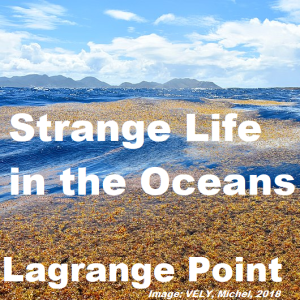
Sunday Jul 14, 2019
Sunday Jul 14, 2019
Water, water everywhere but not a drop to drink or nutrient for that matter. The Ocean can sometimes be a inhospitable place with barely any nutrients to survive off. Other times it can be home to large ocean spanning algae blooms. The oceans from the Pacific to the Atlantic can hold lots of secrets (even fresh water) beneath the surface. This week we look at 3 different papers which outline strange parts of the ocean, from large algae blooms to hidden aquifers.
References:
- Greta Reintjes, Halina E. Tegetmeyer, Miriam Bürgisser, Sandi Orlić, Ivo Tews, Mikhail Zubkov, Daniela Voß, Oliver Zielinski, Christian Quast, Frank Oliver Glöckner, Rudolf Amann, Timothy G. Ferdelman, Bernhard M. Fuchs. On-Site Analysis of Bacterial Communities of the Ultraoligotrophic South Pacific Gyre. Applied and Environmental Microbiology, 2019; 85 (14) DOI: 10.1128/AEM.00184-19
- Mengqiu Wang, Chuanmin Hu, Brian B. Barnes, Gary Mitchum, Brian Lapointe, Joseph P. Montoya. The great Atlantic Sargassum belt. Science, 2019; 365 (6448): 83 DOI: 10.1126/science.aaw7912
- Chloe Gustafson, Kerry Key, Rob L. Evans. Aquifer systems extending far offshore on the U.S. Atlantic margin. Scientific Reports, 2019; 9 (1) DOI: 10.1038/s41598-019-44611-7
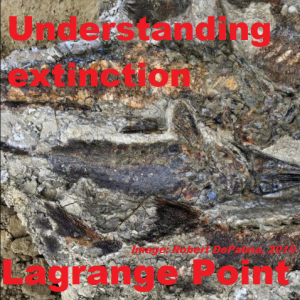
Monday Apr 01, 2019
Episode 320 - Extinction events and their causes
Monday Apr 01, 2019
Monday Apr 01, 2019
Life has been around on earth for a long time, but there have been many extinction events that have wiped out large numbers of species. This week we find out how scientists peel back the layers of rock to uncover what caused these extinction events. Plus we find out about current extinction events and what we can learn from the past to protect species today.
References:
- DePalma, Robert A.; Smit, Jan; Burnham, David; Kuiper, Klaudia; Manning, Phillip; Oleinik, Anton; Larson, Peter; Maurrasse, Florentin; Vellekoop, Johan; Richards, Mark A.; Gurche, Loren; Alvarez, Walter. Prelude to Extinction: a seismically induced onshore surge deposit at the KPg boundary, North Dakota. PNAS, 2019
- Ben C. Scheele et al. Amphibian fungal panzootic causes catastrophic and ongoing loss of biodiversity. Science, 2019 DOI: 10.1126/science.aav0379
- Seth A. Young, Andrew Kleinberg, Jeremy D. Owens. Geochemical evidence for expansion of marine euxinia during an early Silurian (Llandovery–Wenlock boundary) mass extinction. Earth and Planetary Science Letters, 2019; 513: 187 DOI: 10.1016/j.epsl.2019.02.023
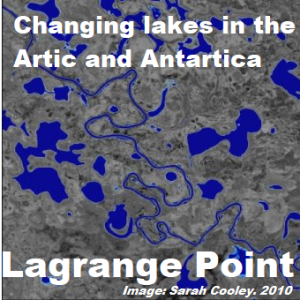
Monday Mar 25, 2019
Monday Mar 25, 2019
Trying to understand how the climate will change is difficult. For every big event like the break up of an ice shelf, there are thousands of little factors that play a role. Sometimes this little things turn into a torrent of a river, or a calm lake which can cause an entire continent to bend and flex. We find out about research into the Arctic Tundra and it's changing lakes which are one of the largest natural emitters of greenhouse gases. Plus ways to capture greenhouse gases and store them safely.
References:
- Alison F. Banwell, Ian C. Willis, Grant J. Macdonald, Becky Goodsell, Douglas R. MacAyeal. Direct measurements of ice-shelf flexure caused by surface meltwater ponding and drainage. Nature Communications, 2019; 10 (1) DOI: 10.1038/s41467-019-08522-5
- Sarah W. Cooley, Laurence C. Smith, Jonathan C. Ryan, Lincoln H. Pitcher, Tamlin M. Pavelsky. Arctic‐Boreal lake dynamics revealed using CubeSat imagery. Geophysical Research Letters, 2019; DOI: 10.1029/2018GL081584
- Fundação de Amparo à Pesquisa do Estado de São Paulo. (2019, February 13). Carbon gas storage cavern is the best way to obtain clean energy from a fossil fuel. ScienceDaily. Retrieved February 15, 2019 from www.sciencedaily.com/releases/2019/02/190213124358.htm

Monday Feb 25, 2019
Episode 315 - Asteroids, meteorites and the destruction of moons
Monday Feb 25, 2019
Monday Feb 25, 2019
It's easy to think of the solar system as a static object that's always been there. But by studying asteroids, meteorites and moons we can piece together the often violent and dramatic history of our solar system. From Earth being bombarded by water bearing asteroids, to moons being broken apart and reformed around Neptune. We even follow up on some of the great work done by JAXA and the Hyabusa 2 mission. This week we look at some of the latest research into our solar system by studying the smallest often overlooked pieces.
References:
- Josep M. Trigo-Rodríguez, Albert Rimola, Safoura Tanbakouei, Victoria Cabedo Soto, Martin Lee. Accretion of Water in Carbonaceous Chondrites: Current Evidence and Implications for the Delivery of Water to Early Earth. Space Science Reviews, 2019; 215 (1) DOI: 10.1007/s11214-019-0583-0
- Rincon, P. (2019, February 21). Hayabusa-2: Japan mission set to 'bite an asteroid'. Retrieved from https://www.bbc.com/news/science-environment-47293317
- M. R. Showalter, I. de Pater, J. J. Lissauer, R. S. French. The seventh inner moon of Neptune. Nature, 2019; 566 (7744): 350 DOI: 10.1038/s41586-019-0909-9
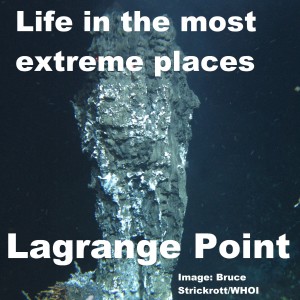
Monday Feb 18, 2019
Episode 314 - Ancient life and life in extreme places
Monday Feb 18, 2019
Monday Feb 18, 2019
From the bottom of the ocean, to the earliest days of the earth, life has managed to not just survive but thrive. We look at several cases which change our understanding of the earliest life on earth and just what that might mean for understanding life on this planet and beyond. From moving life fossilised in mud, to using isotopes to study metabolism and discovering whole new methods of getting food, life continues to astound researchers with its inventiveness.
References:
- Min Sub Sim, Hideaki Ogata, Wolfgang Lubitz, Jess F. Adkins, Alex L. Sessions, Victoria J. Orphan, Shawn E. McGlynn. Role of APS reductase in biogeochemical sulfur isotope fractionation. Nature Communications, 2019; 10 (1) DOI: 10.1038/s41467-018-07878-4
- Abderrazak El Albani, M. Gabriela Mangano, Luis A. Buatois, Stefan Bengtson, Armelle Riboulleau, Andrey Bekker, Kurt Konhauser, Timothy Lyons, Claire Rollion-Bard, Olabode Bankole, Stellina Gwenaelle Lekele Baghekema, Alain Meunier, Alain Trentesaux, Arnaud Mazurier, Jeremie Aubineau, Claude Laforest, Claude Fontaine, Philippe Recourt, Ernest Chi Fru, Roberto Macchiarelli, Jean Yves Reynaud, François Gauthier-Lafaye, Donald E. Canfield. Organism motility in an oxygenated shallow-marine environment 2.1 billion years ago. Proceedings of the National Academy of Sciences, 2019; 201815721 DOI: 10.1073/pnas.1815721116
- Stephanie A. Carr, Sean P. Jungbluth, Emiley A. Eloe-Fadrosh, Ramunas Stepanauskas, Tanja Woyke, Michael S. Rappé, Beth N. Orcutt. Carboxydotrophy potential of uncultivated Hydrothermarchaeota from the subseafloor crustal biosphere. The ISME Journal, 2019; DOI: 10.1038/s41396-019-0352-9

Monday Dec 17, 2018
Episode 305 - Reaching space, the darkside of the moon and wet asteroids
Monday Dec 17, 2018
Monday Dec 17, 2018
It's been a busy week in space news from Virgin Galactic finally reaching space, to wet asteroids and even a mystery in space. We find out about the latest missions to investigate surprisingly damp asteroids by JAXA and NASA. We recap the swirling controversy around a mysterious hole in the Soyuz spacecraft, plus the latest on Chang'e-4's journey to the dark side of the moon.
- Antczak, J. (n.d.). Virgin Galactic tourism rocket ship reaches space in test. Retrieved from https://phys.org/news/2018-12-virgin-galactic-rocket-ship-space.html
- Jones, A. (2018, December 12). Chang'e-4 spacecraft enters lunar orbit ahead of first-ever far side landing. Retrieved from https://spacenews.com/change-4-spacecraft-enters-lunar-orbit-ahead-of-first-ever-far-side-landing/
- Yamaguchi, M. (n.d.). Photos from Japan space rovers show rocky asteroid surface. Retrieved from https://phys.org/news/2018-12-photos-japan-space-rovers-rocky.html
- Materials provided by University of Arizona. Original written by Erin Morton/OSIRIS-REx and Daniel Stolte. Note: Content may be edited for style and length.
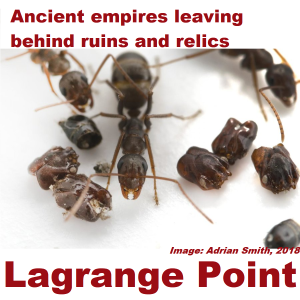
Monday Nov 26, 2018
Monday Nov 26, 2018
This week we find out about ancient empires which have changed the face of the planet, changed the climate and left behind trophies of their conquests. From pyramid building termites in Brazil, to large climate changing colonies in Spain and even David vs Goliath battles in Florida with trophies of the dead.
- Stephen J. Martin, Roy R. Funch, Paul R. Hanson, Eun-Hye Yoo. A vast 4,000-year-old spatial pattern of termite mounds. Current Biology, 2018; 28 (22): R1292 DOI: 10.1016/j.cub.2018.09.061
- David Martín-Perea, Omid Fesharaki, M. Soledad Domingo, Sara Gamboa, Manuel Hernández Fernández. Messor barbarus ants as soil bioturbators: Implications for granulometry, mineralogical composition and fossil remains extraction in Somosaguas site (Madrid basin, Spain). CATENA, 2019; 172: 664 DOI: 10.1016/j.catena.2018.09.018
- Adrian A. Smith. Prey specialization and chemical mimicry between Formica archboldi and Odontomachus ants. Insectes Sociaux, 2018; DOI: 10.1007/s00040-018-0675-y
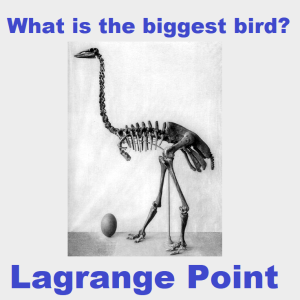
Monday Oct 01, 2018
Episode 294 - What is the biggest bird; Island Giants and dwarfs.
Monday Oct 01, 2018
Monday Oct 01, 2018
What is the biggest bird? Why do some species in some locations end up becoming giants? What makes islands like Madagascar so special and why are so many of the species once found there so very large in size? This week we look at island gigantism and island dwarfism across the world with a focus on the giant Elephant birds of Madagascar.
References:
- James P. Hansford, Samuel T. Turvey. Unexpected diversity within the extinct elephant birds (Aves: Aepyornithidae) and a new identity for the world's largest bird. Royal Society Open Science, 2018; 5 (9): 181295 DOI: 10.1098/rsos.181295
- James Hansford, Patricia C. Wright, Armand Rasoamiaramanana, Ventura R. Pérez, Laurie R. Godfrey, David Errickson, Tim Thompson, Samuel T. Turvey. Early Holocene human presence in Madagascar evidenced by exploitation of avian megafauna. Science Advances, 2018; 4 (9): eaat6925 DOI: 10.1126/sciadv.aat6925
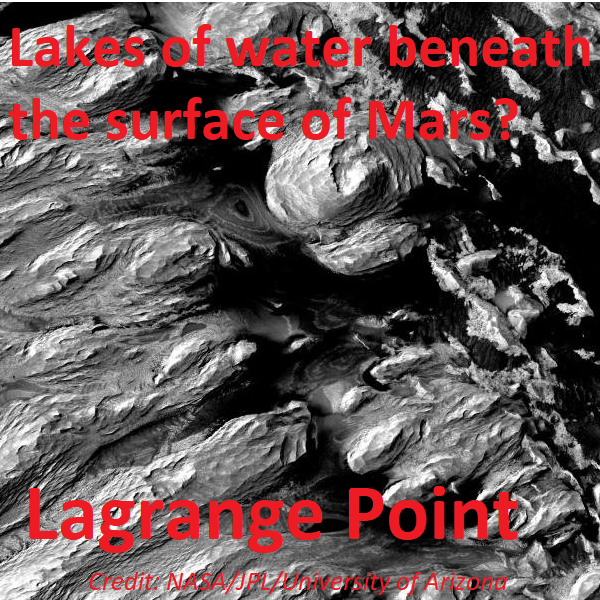
Monday Jul 30, 2018
Monday Jul 30, 2018
We are often tantalized by the prospect of water on Mars, but thanks to a Teenage Satellite we have found lakes of water on Mars, just beneath the surface. Plus we find out where all that martian dust comes from and check in on everyone's favourite Comet, 67-p.
- R. Orosei, S. E. Lauro, E. Pettinelli, A. Cicchetti, M. Coradini, B. Cosciotti, F. Di Paolo, E. Flamini, E. Mattei, M. Pajola, F. Soldovieri, M. Cartacci, F. Cassenti, A. Frigeri, S. Giuppi, R. Martufi, A. Masdea, G. Mitri, C. Nenna, R. Noschese, M. Restano, R. Seu. Radar evidence of subglacial liquid water on Mars. Science, 2018; eaar7268 DOI: 10.1126/science.aar7268
- Horner, J. (2018, July 26). Discovered: A huge liquid water lake beneath the southern pole of Mars. Retrieved from http://theconversation.com/discovered-a-huge-liquid-water-lake-beneath-the-southern-pole-of-mars-100523
- Lujendra Ojha, Kevin Lewis, Suniti Karunatillake, Mariek Schmidt. The Medusae Fossae Formation as the single largest source of dust on Mars. Nature Communications, 2018; 9 (1) DOI: 10.1038/s41467-018-05291-5
- K. L. Heritier, K. Altwegg, J.-J. Berthelier, A. Beth, C. M. Carr, J. De Keyser, A. I. Eriksson, S. A. Fuselier, M. Galand, T. I. Gombosi, P. Henri, F. L. Johansson, H. Nilsson, M. Rubin, C. Simon Wedlund, M. G. G. T. Taylor, E Vigren. On the origin of molecular oxygen in cometary comae. Nature Communications, 2018; 9 (1) DOI: 10.1038/s41467-018-04972-5
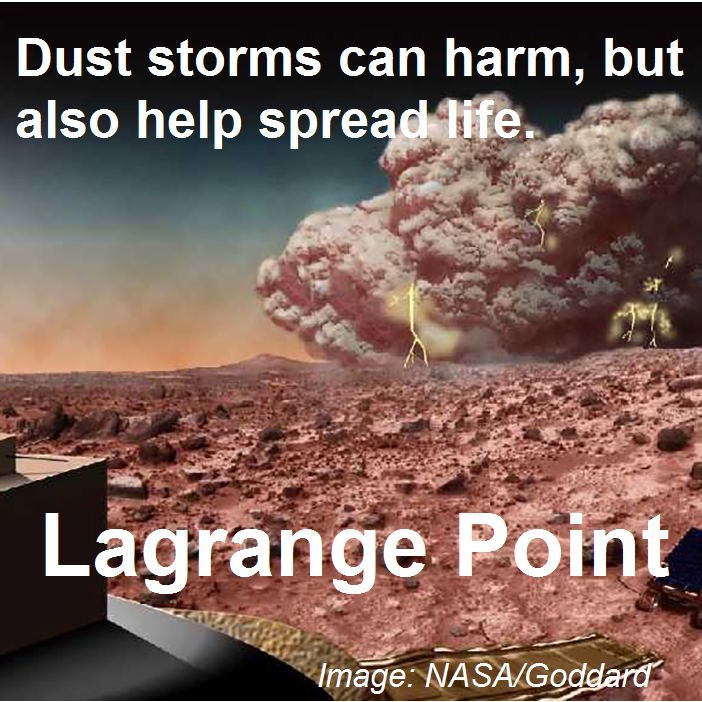
Monday Jul 16, 2018
Episode 283 - Dust storms carrying life, harming life and engulfing a planet
Monday Jul 16, 2018
Monday Jul 16, 2018
Dust storms can be hazardous, especially when they engulf an entire planet like on Mars. They can also carry pollution across national borders and contaminate wide areas. But Dust Storms may also hold the secret for how life can spread across vast deserts. This week we look at dust storms of this world and out of this world.
- Authors: J. A. Rivas Jr., J. E. Mohl, R. S. Van Pelt, M.‐Y. Leung, R. L. Wallace, T. E. Gill, E. J. Walsh. Evidence for regional aeolian transport of freshwater micrometazoans in arid regions. Limnology and Oceanography Letters, 2018; DOI: 10.1002/lol2.10072
- Tuyet Nam Thi Nguyen, Kuen-Sik Jung, Ji Min Son, Hye-Ok Kwon, Sung-Deuk Choi. Seasonal variation, phase distribution, and source identification of atmospheric polycyclic aromatic hydrocarbons at a semi-rural site in Ulsan, South Korea. Environmental Pollution, 2018; 236: 529 DOI: 10.1016/j.envpol.2018.01.080
- Penn State. (2018, June 28). Mars dust storm may lead to new weather discoveries. ScienceDaily. Retrieved July 14, 2018 from www.sciencedaily.com/releases/2018/06/180628124412.htm
- NASA/Goddard Space Flight Center. (2018, June 20). Martian dust storm grows global: Curiosity captures photos of thickening haze. ScienceDaily. Retrieved July 13, 2018 from www.sciencedaily.com/releases/2018/06/180620170956.htm
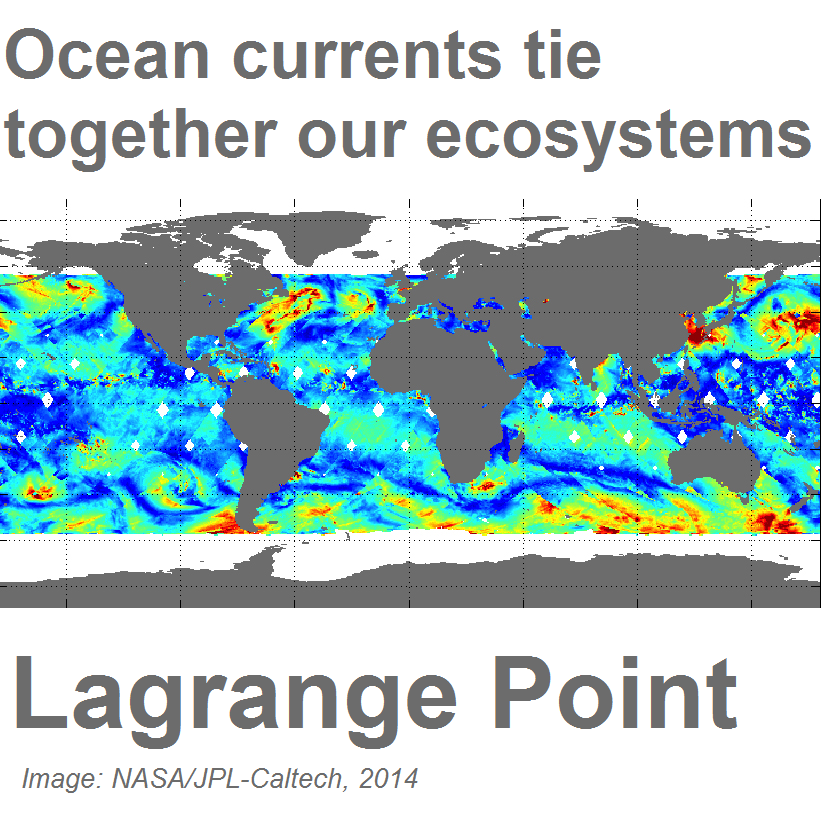
Monday Jul 02, 2018
Monday Jul 02, 2018
This week we look into three stories about how oceans tie our planet together. Our ecosystems are often linked in unusual ways that are not immediately obvious. Ocean currents can tie ecosystems across the world together, impacting migratory species, local environments and ecosystems. Sometimes these impacts are short term, other times they play out over years, decades and centuries.
References:
- Carl J. Reddin, Ádám T. Kocsis, Wolfgang Kiessling. Marine invertebrate migrations trace climate change over 450 million years. Global Ecology and Biogeography, 2018; DOI: 10.1111/geb.12732
- Hector M. Guzman, Catalina G. Gomez, Alex Hearn, Scott A. Eckert. Longest recorded trans-Pacific migration of a whale shark (Rhincodon typus). Marine Biodiversity Records, 2018; 11 (1) DOI: 10.1186/s41200-018-0143-4
- Jocelyn Champagnon, Jean-Dominique Lebreton, Hugh Drummond, David J. Anderson. Pacific Decadal and El Niño oscillations shape survival of a seabird. Ecology, 2018; 99 (5): 1063 DOI: 10.1002/ecy.2179

